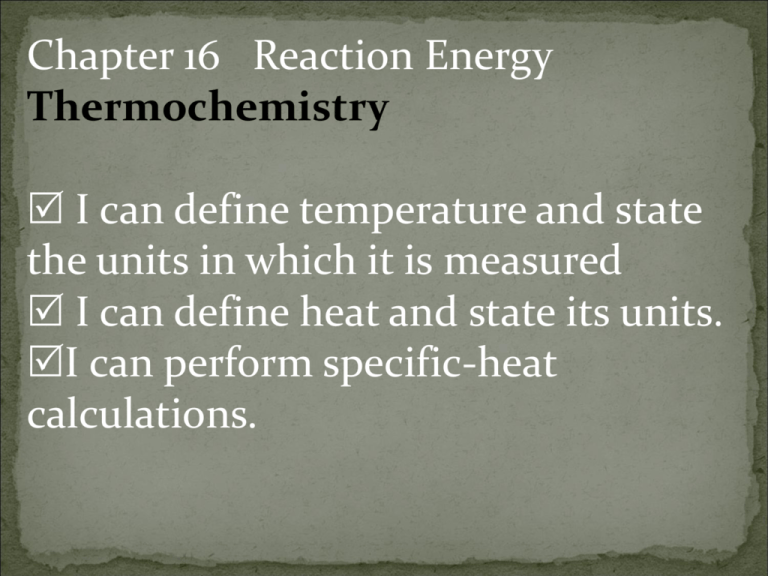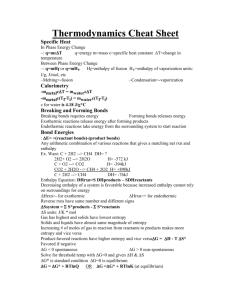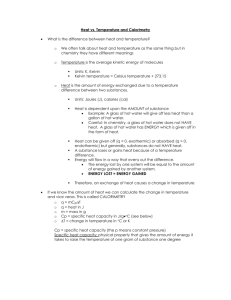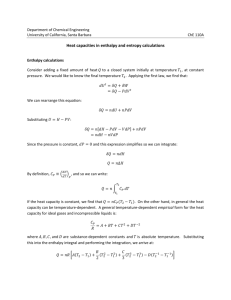honors chem chpt 16 thermo
advertisement

Chapter 16 Reaction Energy Thermochemistry I can define temperature and state the units in which it is measured I can define heat and state its units. I can perform specific-heat calculations. What is thermochemistry? …. the study of the transfer of energy as heat that accompany chemical reactions and physical changes. www.scilinks.org Topic: Heat/Temperature Code: HC60726 Temperature and Heat Temperature is a measure of the average kinetic energy of the particles in a sample of matter. Temperature is measured with a thermometer. Celsius Freezing\melting Kelvin Freezing\melting 0⁰C Boiling 100⁰C 273K Boiling 373K ⁰C = K - 273 K = 273 + ⁰C Fahrenheit vs. Celsius Celsius vs. Kelvin The amount of energy transferred as heat is usually measured in joules, J. A joule is the SI unit of heat as well as all other forms of energy. J = N x m = kg x m2 s2 Calorimeter – Devise used to measure the energy absorbed or released as heat in a chemical or physical change. Simple Coffee Cup Calorimeter Heat – The energy transferred between samples of matter because of a difference in their temperatures. Energy transfers from warmer objects to cooler objects. SPECIFIC HEAT … the amount of energy required to raise the temperature of one gram of a substance by one Celsius degree 1⁰C) or one Kelvin (1K). So… if you have a high specific heat value, what does that mean by definition? http://www.chem1.com/acad/webtext/chem bond/cb01.html#SEC1 cp = q q = cp x m x T m x T cp = specific heat at constant pressure q = heat energy lost or gained m = mass of the sample T = difference between the initial and final temperatures Sample problem A, page 533 A 4.0 g sample of glass was heated from 274 K to 314 K, a temperature increase of 40.0 K , and was found to have absorbed 32 J of energy as heat energy. a.What is the specific heat of this type of glass? b.How much energy will the same glass sample gain when it is heated from 314 K to 344 K? Practice, page 534 1.Determine the specific heat of a material if a 35 g sample absorbed 96 J as it was heated from 293 K to 313 K. 2.If 980 J of energy are added to 6.2 g of a substance at 291 K. The final temperature is 311K. What is the specific heat of this substance. Additional practice go.hrw.com keyword HC6NRGX Enthalpy of Reaction Enthalpy change is the amount of energy absorbed by a system as heat during a process at constant pressure. H, change in enthalpy. Enthalpy for a reaction H = H products – H reactants Enthalpy of reaction…. is the quantity of energy transferred as heat during a chemical reaction. Exothermic - energy is released (given off) feels warm Endothermic – energy is absorbed (taken in) feels cool Thermochemical Equation … an equation that includes the quantity of energy released or absorbed as heat during the reaction as written. 2H2 (g) + O2 (g) 2H2O(g) + 483.6 kJ In an exothermic chemical reaction the enthalpy change is negative meaning energy is released from the system as heat In an endothermic chemical reaction the enthalpy change is positive meaning energy is absorbed into the system as heat Driving Force of Reactions Learning Target: I can explain the relationship between enthalpy change and the tendency of a reaction to occur. I can explain the relationship between entropy change and the tendency of a reaction to occur. Driving Force of Reactions The change in energy of a reaction system is one of two factors that allow chemists to predict whether a reaction will occur spontaneously and to explain how it occurs. The randomness of the particles in a system is the second factor affecting whether a reaction will occur spontaneously. Entropy Entropy, S, is the tendency toward randomness. It is defined as a measure of the degree of randomness of the particles such as molecules, in a system www.scilinks.org Topic: Entropy Code: HC60523 Solid – particles are fixed in position – degree of randomness is low – low entropy Liquid – particles can move – system more random – higher entropy Gas – particles moving rapidly – most random – highest entropy







